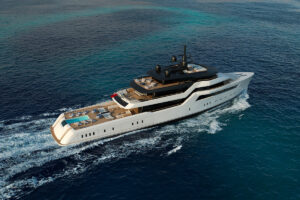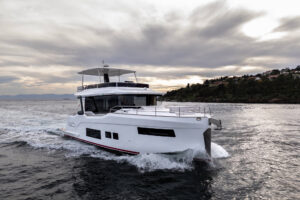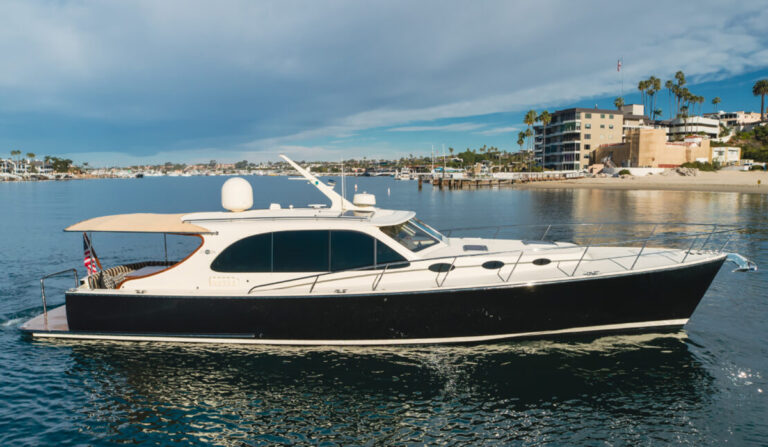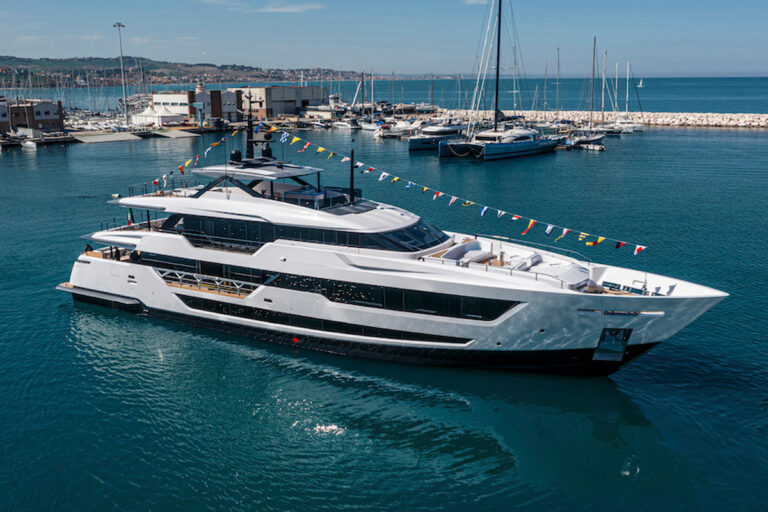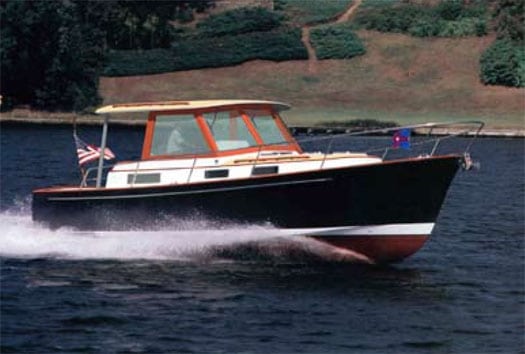
ytgjan09obbruck525.jpg
Swollen by heavy rain, the Connecticut River at Essex sped south at about 4 knots. Its waters, the color of weak café au lait, carried enough raw timber to build a Banks schooner, but we soldiered onward under sharp lookout. I was aboard the new Bruckmann 34e on a damp and misty day in May. Her designer, Mark Ellis, had joined me for this sea trial to reacquaint himself with the boat and to experiment with the trim tabs and find their optimum setting. Photographs of the boat, taken right after the Newport International Boat Show showed her trimmed down by the bow and plowing a furrow. These images bothered Ellis.
Odd how little things take on so much importance. Someone must have dialed in full tabs, and it worried Ellis, because she doesn’t really need trim tabs. You might use them to balance an uneven distribution of weight created by careless stowage of gear or all the guests crowding into one corner or another. When you’re battling a headwind and a steep, short chop, you may add a little tab to let the steepest part of the deadrise strike the first punch, smoothing the ride. Tabs also correct the listing caused by running in fresh beam winds. Otherwise, the bottom takes care of most conditions simply because of its shape-shapes, really.
The Bruckmann 34e rides on a type of bottom that Ellis first drew for a custom 39-footer built by Bruckmann Yachts in 1994. Heavily influenced by the work of C. Raymond Hunt, for whom he worked in the late 1960s, Ellis created an unusual iteration of that designer’s legendary deep-V. From the stem aft to slightly forward of amidships, the bottom has the usual steep deadrise and fine sections of a deep-V, but it doesn’t have the lifting strakes we’re accustomed to seeing. Instead, Ellis has drawn a single chine on each side. These chines grow from very narrow at the stem to very wide at the transom, and if you follow their sweep aft in profile, you’ll see an echo of the sweep in the sheerline. These chines pierce the static waterline forward of amidships, becoming deeper on their run to the transom, and they provide all the lift she needs to hoist herself onto plane. In fact, the trim angle of the 34e changes very little as it accelerates from rest to its maximum speed of 24 knots.
Back aft things get very different. Ellis drew a flat, which sweeps up from the keel near the forward end of the planing area, growing shallower and wider as it does so, and ends in a straight flat in way of the rudder. A skeg grows from the leading end of this cutaway and appears to be parallel to the static waterline until it becomes deeper to accommodate the propeller. The deadrise on each side of the cutaway section, or flat, is about 22 degrees-same as you’ll find on many conventional deep-V bottoms. This flat area promotes lift, and along with the wide chines in the after sections, enhances the boat’s lateral stability when it’s at rest or cruising at low speeds. The flat also reduces the down-angle of the propeller and shaft, making the prop more efficient and reducing draft.
In practice, this unusual bottom is a pleasure to experience. For one thing, it allows her to plane at the relatively low speed of 12 knots during acceleration and to stay on plane down to 10 knots. In rough water, this ability to maintain plane at such a low speed-without squatting-gives the boat an exceptionally seakindly and dry ride. But the bottom also encourages the boat to keep its course in following seas, even when you slow to 10 to 12 knots. Like any good deep-V, it tracks like a freight train at all planing speeds. Ellis told me that one of Ray Hunt’s favorite tricks during demonstrations of the deep-V was to leave the helm and let the boat take care of itself.The Bruckmann 34e does likewise.
Bruckmann Yachts, under the guidance of Mark Bruckmann, builds the 34e to the highest quality, maintaining a heritage of fine craftsmanship that dates back to the canoes built by native Canadians long before the European explorers set foot on the land, and continued through the heyday of mahogany runabouts into the current production of fiberglass and aluminum cruising and racing boats. Sighting along the topsides confirms the high quality of the tooling- no ripples to be found. The joinery is second to none, and the interior recalls that of the Herreshoff era-mostly white with varnished cherry trim. Bruckmann uses Core-Cell foam coring in the laminate, and the solid feel of the boat as it glides over the water tells us that the hull is stiff and strong.
The Bruckmann 34e made its public debut at the 2007 Newport show. Eastland Yachts, in Essex, Connecticut, will market the boat throughout the Northeast. Although the hull and deck are stock items, Bruckmann will entertain modifications to suit an individual owner’s needs, as long as the requests fall within the boundaries of the tooling.
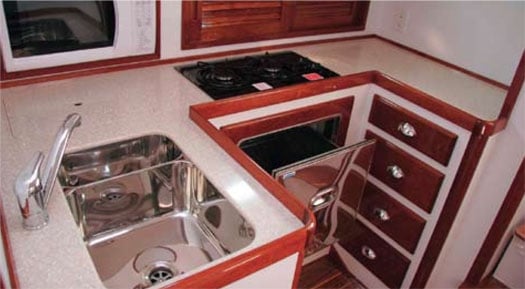
| | |
If I bought a Bruckmann 34e, I wouldn’t change a thing. She is an ideal size for solo operation or a husband-and-wife team. The accommodations belowdecks are perfect for a couple who wants to cruise among the many nooks and crannies of the Atlantic coastline from Maine to Florida, poke around the enchanting Puget Sound or Chesapeake Bay, or explore the thousands of miles of inland waterways. The V-berth is private and comfortable, the galley seamanlike and well equipped, the head and shower spacious enough for a fullsize adult. Curtains of canvas and clear vinyl weatherproof the bridge deck on three sides so meals can be enjoyed at the dinette on the bridge deck come rain or shine. The sides slide forward in a groove, so you can open the area to a breeze without taking down the curtains. Add the economical operation of the single engine, and you have the recipe for many pleasant hours afloat.
Bruckmann Yachts, (800) 254-7618; www.bruckmannyachts.com

